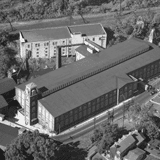PLACE
Northwest Baltimore, the south side of Hampden, just north of Remington. Flanked on the west by the expansive Druid Hill Park and the narrow Wynam Park greenway on the east. In the shade of the loading docks and weedy overgrowth lining the Jones Falls stream that extends from Lake Roland six miles north through the industrial maze of Baltimore and into the bay. At the gravelly bend on Falls Road where Chestnut Avenue comes to a T: The Mount Vernon Mill.
 HISTORY
HISTORY
In 1847 Mount Vernon was a cotton mill, one of the nation’s premier producers of cotton duck, or canvas. A fire destroyed the campus in 1872, at which time the Mount Vernon Company began construction on what would make up the present, 10-acre mill complex.
The site consists of four separate buildings: Mount Vernon Mill No. 1, a three-story brick mill house originally built in 1873; Picker House, a two-story, L-shaped brick building also built in 1873 with an expansion added in 1879; a two-story brick Store House, circa 1881; and a later-reinforced concrete warehouse, circa 1918, connected to Mill No. 1 via a pedestrian bridge.
In 1973, the Mount Vernon Company relocated to North Carolina and sold the old property to a hobby retailer and supplier, which kept the buildings busy and well-stocked into the early 2000s. Mill No. 1 was added to the National Register of Historic Places in 2003, and the retailer began to decrease operations toward the end of the decade. Then, in 2009, David Tufaro of Terra Nova Ventures entered into an option contract to acquire the site and identified an opportunity for the mill’s adaptive potential by converting it to a modern, mixed-use development while preserving and strengthening its historical importance.
STRATEGY
Specializing in difficult historic-real-estate revitalization and development, Tufaro and Terra Nova Ventures saw the adaptive reuse of the mill as a green project and also as a strategic opportunity to bring new life—environmental and economic—to the Jones Fall throughway.
When Tufaro ran for mayor of Baltimore in 1999, urban development was one of his primary campaign initiatives, and though he ultimately lost the vote, he stayed true to his promises. “You need to present a really good case if you want to take down an old building, and people generally don’t do this,” Tufaro says. “I like old buildings especially because many of them were so well-engineered, and I like to see them reused.”
 SPACE
SPACE
After Terra Nova executed the contract in 2009, it spent the next year and a half acquiring financing for the project, officially beginning renovation in early 2012. The project is converting the 4,000-square-foot boiler room and 4,400-square-foot Picker building into restaurant spaces with exposed stone and brick walls, vaulted ceilings, and views overlooking the stream. More than 40,000 square feet of office space will also be created, alongside 92 apartments averaging 908 square feet per unit.
“Though a mixed-use plan for a site like this is always a good idea, our decision was partly motivated by parking and financial constraints,” Tufaro says. “The constraints were a challenge, but led us to make some interesting decisions about the project.”
BUILD
The primary sustainable element of the revitalization has to do with the overall character of the project, which features no new construction aside from an extra pedestrian bridge connecting the warehouse building to Mill No. 1, substantially reducing project costs and withdrawing the need for an expanded building footprint.
Recycled building materials, energy-efficient appliances and HVAC systems, automated lighting, and low-glazing windows also are being used, and the concrete warehouse building will feature a green roof. “We’re abiding by the Baltimore city LEED-equivalent green building standards,” Tufaro says, “and we’re not increasing any non-pervious surfaces on the site.”
Complementing the work at the mill, Terra Nova is also working to create biohabitats with nonprofit organization Blue Water Baltimore on a separate Jones Fall stream restoration. “The work we’re doing on the Mount Vernon Mill is really the most representative of the work we’re doing at Terra Nova,” Tufaro says, “and it has been really exciting to engage the community with the project.”

